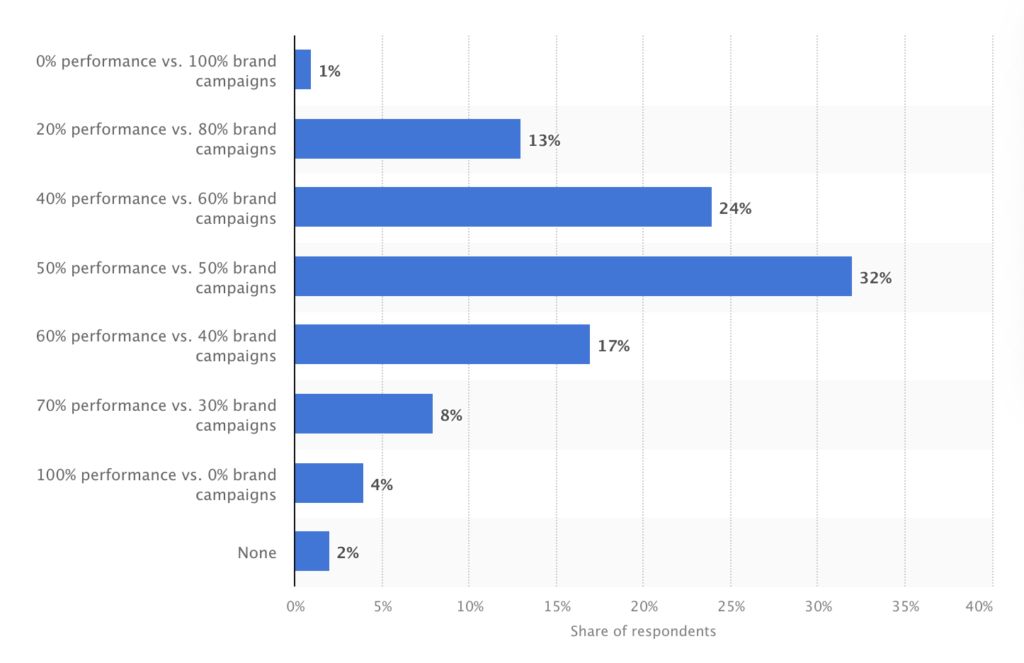
Finding the Right Balance: Performance Marketing vs Brand Marketing
- Understanding the differences between Performance and Brand Marketing strategies
- The Pros and Cons list for each strategy
- How you can bring them together to increase your marketing ROI
Marketing is a vital component of any business, and there are different approaches to it. In the past, performance marketing and brand marketing were seen as two distinct disciplines.
Performance marketing was focused on driving immediate results, such as website traffic or conversions, while brand marketing was focused on building long-term brand awareness and loyalty. However, in recent years, there has been a growing need to connect these two marketing strategies.
What Is Brand Marketing?
Brand Marketing is the process of creating and managing a brand. It involves developing a brand identity, positioning the brand in the marketplace, and building brand awareness and loyalty. Brand marketing is an important part of any company’s marketing strategy, as it can help to differentiate the company’s products or services from those of its competitors.
A focus on Brand Marketing is a focus on the company. You’re working on telling your story, showing your creative logo and brand colors, and creating a cohesive look, feel, and voice to your company. By building a strong brand, a strong style, you are creating strong brand loyalty and lifelong customers.
What Is Performance Marketing?
Performance Marketing is a data-driven approach that aims to maximize the return on investment (ROI) of marketing campaigns. It involves setting measurable goals, analyzing data, and optimizing campaigns to achieve the desired results. The focus is on driving immediate sales or conversions rather than building long-term brand equity.

Share of budgets devoted to Performance vs. Brand Marketing according to marketers in the United States as of June 2019 • Statista
The Pros and Cons
While performance marketing can deliver immediate results, it should not be the only strategy you use. An article in Forbes notes that “when businesses focus solely on performance marketing, they risk becoming overly reliant on it and failing to build their brand for long-term growth.” Building a strong brand requires consistent messaging and positioning, which can be challenging to achieve with a purely performance-driven approach.
“Brands won’t succeed if they try to turn marketing exclusively into ones and zeros” –Jeff Weiser, former CMO at Shopify Inc.
However, brand marketing may take longer to show results, but it can pay off in the long run. A strong brand can help a business stand out in a crowded market, create customer loyalty, and increase customer lifetime value. By building a strong brand, businesses can create a sustainable competitive advantage that is difficult for competitors to replicate.
See Related:
- Harvard Business Review: How Brand Building and Performance Marketing Can Work Together
- Wall Street Journal: More Companies Are Hiring CMOs with Performance Marketing Backgrounds
- Forbes: Balancing Act: Brand Building Vs. Performance Marketing
- Raconteur: What happens when brand and performance marketing join forces
Bringing the Two Together
As companies face increasing pressure to deliver results quickly, more and more are hiring CMOs with a background in performance marketing. According to a study by Spencer Stuart, the average tenure of a chief marketing officer (CMO) is only 3.5 years. A Wall Street Journal article reports that “the number of CMOs with a performance marketing background has increased from 5% to 20% in the past five years.”
Pitting brand building and performance marketing against each other in a competition for budget unnecessarily damages the effectiveness of both. –Harvard Business Review
There are a number of reasons you should combine Performance and Brand Marketing strategies (and not just because more companies are looking for CMOs with the right background). We’ll look at the top 3 reasons.
First, digital marketing has made it possible to track the effectiveness of marketing campaigns in real time. This has made it easier for marketers to measure the impact of both performance marketing and brand marketing campaigns.
Second, as the cost of marketing continues to rise and consumers become more sophisticated, companies will need to find ways to get more bang for their buck. Performance marketing can help them increase their campaign success by providing them with a way to track the effectiveness of their brand campaigns and make adjustments as needed.
Lastly, as the times change, consumers are growing more discerning. With marketing messages coming at them from all directions, they tend to disregard messages that lack relevance or emotional appeal. By blending performance marketing with brand marketing, marketers can craft messages that are not only pertinent but compelling.
Example Opportunities
One opportunity is to use performance marketing to drive traffic to brand marketing content. For example, a company could use paid search ads to drive traffic to its website, where it could then promote its brand through blog posts, articles, and videos.
Another way is to use brand marketing to create awareness for performance marketing campaigns. For example, a company could create a viral video that promotes its new product. The video could then be used to drive traffic to a landing page where users could sign up for a free trial of the product.
Finding the Balance
The combination of Performance Marketing and Brand Marketing is a positive development for marketers. By finding the right balance between the two approaches, businesses can create a marketing strategy that delivers both short-term gains and long-term success.













Pingback: How User Expectations are Changing Experiences - Interest Media